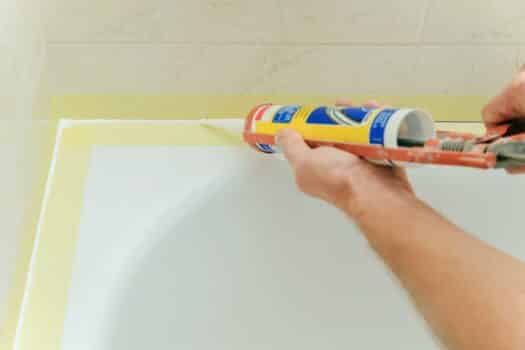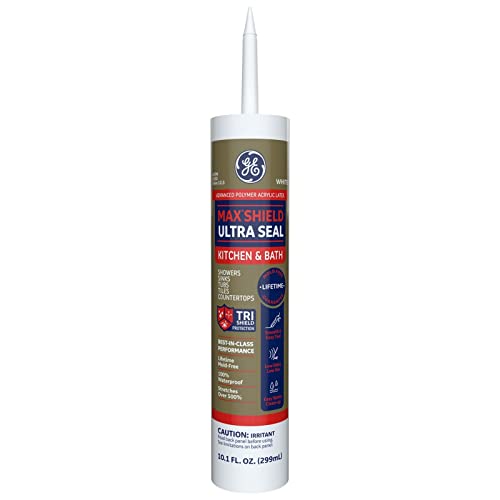If you are looking to purchase affordable caulking compounds, then the painter’s caulk will serve you well. But are you confused about what it is?
Painter’s caulk is an acrylic latex compound that can be used to smoothen a surface before it is painted. It is often used as a sealant to ensure that all irregular gaps are filled. Cured caulk will give you a paintable layer and is one of the most affordable options out there.
- Paintable: Paint-ready in 30 minutes and...
- Durable: 100% waterproof and backed by a 60-year...
If you have a small hole that needs sealing before the paint can be applied on the brick walls near joints, this will help you out. We will discuss it further in the sections below.
So, grab a cup of your favorite beverage and read on!
What Is A Painter’s Caulk Needed For?

Painter’s caulk is the perfect option for those who do not want to spend a lot of money buying caulk or other expensive sealants. But you may have to choose a silicone sealant in case of mold and mildew growth, which falls in a pricier range.
It’s worth noting that the painter’s caulk works very well, and you will not have to waste any money as it is known as one of the most affordable caulking compounds. It can be used for a number of purposes, and we will talk about a few here.
1. Repairing
In case you want to repair or fill any small holes and irregularities, then the painter’s caulk will work very well. It is often kept handy and used on different surfaces when needed. Many use it as a temporary option till they find something that can work better.
2. Adhesive
A lot of people apply painter’s caulk to hold two surfaces together. However, you should know that acrylic latex caulks will not be able to hold heavy or thick surfaces. But you can use it with a thinner substance to cover the gaps in between the layers.
3. Window And Door Frames
Acrylic latex caulk can also be used to seal the areas around doors and windows. You can apply it to interior walls and siding. It works the best with vertical joints and not horizontal joints, which will not see a lot of movement. In the case of moving joints, it is best to search for a different caulk.
4. Sealing Joints
The caulk works very well with small joints and can be used to fill up the gaps. For example, there might be gaps between rafters and wall coverings. The seal is generally airtight, and you can achieve a smooth texture.
5. Areas To Be Painted
The painter’s caulk is named so for a reason, and it is a favorite among painters. It is very non-conspicuous, and you will be able to paint all over the surface after its application.
How To Use a Painter’s Caulk?
This is a type of sealant that can be used to seal a number of surfaces, and it is easy to use. You can purchase a caulking gun that can be reused time and again. The secret to perfect caulking is to cut off the nozzle end according to the required width of the gap that needs to be filled.
Now there can be different gaps beside windows and door frames, and you will need to cut out different widths. We will recommend beginning with the thinnest gap and cutting the nozzle accordingly. Then cut it a little bigger for the next gap and so on. Always go from the smallest to the largest size, and you won’t face any problems.
While cutting the caulk gun nozzle, you will have to be very careful. You will have to smooth out the edge with a damp finger or a paper towel. This will take care of the uneven edges and ensure you can have a smoothly cut hole. After application, you will need to smoothen the edges with a napkin. This should be done within the first few minutes before the skin forms on top.
Also, we will give you a word of advice here. You can use a nail to block the top end of the nozzle. If you do not have a nail, use anything that can cover the top entirely. This will prevent the caulking compound from drying up. The gaps are generally the size of nail holes, and hence, we would recommend using nails for this purpose.
How To Remove Old Caulks?
If you have an old caulk in place that needs to be removed, you will have to use a knife with a sharp head or a tool specifically made for caulk removal. Use this to remove and dig out the old layer smoothly. There might be debris on top, along with pieces stuck to the crown molding. Acrylic latex caulks are just what you need to cover up such areas.
Once you have removed all the dirt, use a professional cleaning solvent to clean the entire area. You can use any water-based cleaner or denatured alcohol for this process. Please stay away from kerosene, paint thinner or other kinds of hydrocarbon products.
This step is important as the painter’s caulk will never stick to a wet or dirty surface. After cleaning and drying the surface, you can use a caulk gun to apply the acrylic latex caulk onto the surface. Apply even pressure so that you can make a straight and an even line.
Moreover, if you are using soap-and-water-clean-up caulk, then you can use a paper towel to clean the edges. Once the excess amount is removed, then you can use your fingers to press the remaining amount in the gaps.
- Paintable: Paint-ready in 30 minutes and...
- Durable: 100% waterproof and backed by a 60-year...
What Does Not Work With Painter’s Caulk?
While a painter’s caulk has a lot of benefits and may be considered as one of the most affordable caulking compounds, it does not work for all surfaces. Here we will list down the projects that you should not use it for. This may help you prevent unnecessary use of the caulk.
1. Filling Gaps
While you can use a painter’s caulk for sealing small cracks and holes, it cannot be used for large gaps. The gap has to be less than half an inch to ensure perfect functioning. However, any gaps bigger than that will need a stronger caulk. Using the right caulk is necessary to seal joints and gaps. Otherwise, the paint will not stick on top.
2. Exterior Application
While a painter’s caulk works perfectly for interior application, you will need silicone caulk for exterior use. This one is firm and more durable and will last for a long time. Plus, exterior walls and surfaces are often exposed to different weather conditions, and the silicone caulk will work well for it.
3. Areas With Moisture
Painter’s caulk is meant for areas that stay dry, and you can paint over it. But it does not work well in areas that stay wet or experience a lot of moisture. Hence, it is best not to use it inside bathrooms. Get a bathroom caulk to take care of any holes or gaps in the concrete surfaces.
Also, silicone caulks work very well for places with moisture. It can be applied in wet areas and is mold and mildew-resistant. You can apply it with a caulking gun and then shape it with a damp rag or a paper towel. It can also be used on unpainted wood, and water cleanup can be done to prevent the area from getting dirty.
4. Moving Joints
If you have any horizontal joint or moving joint, then the painter’s caulk may not work well. It is not very strong and may come off after some time.
- Paintable: Paint-ready in 30 minutes and...
- Durable: 100% waterproof and backed by a 60-year...
Tips To Remember
There are a few things that you should remember before beginning your work, such as:
1. Suitable Temperature
If the weather is moist or freezing, caulk may not work well. However, if it is averagely dry, then you will be able to work with the painter’s caulk.
2. Adhesion Capacity
Sometimes the painter’s caulk may not stick to cracks or baseboards because the surface might be moist or dirty. So, before you begin caulking, you should always clean the place with soap and water and then let it dry. Once the surface dries up completely, the caulk applies smoothly and will seal the holes and gaps.
3. Drying Up
Caulk will not turn bad, but it can become unusable with time. The substance can turn into a hard layer and can completely dry up if left open. It would be best if you never leave it in an open tin overnight as you will not be able to use it at all the next morning.

Conclusion
There are other alternatives that are often used in place of painter’s caulk, including putty, rubber, silicone, and spray foam. These have different benefits and can often be expensive as sealants. We will recommend assessing the situation well before applying the painter’s caulk.
- Paintable: Paint-ready in 30 minutes and...
- Durable: 100% waterproof and backed by a 60-year...
If you are confused about a specific matter, or you are unable to remove the material from the frames of windows fully, do not worry. Call up professional services and ask them to take care of the job.
On this note, we will be wrapping up, and you can let us know of any further doubts in the comment section below.
Bye and take care!
Related Links
5 Best Electric Power Paint Roller
How Long Should Primer Dry Before Painting
What Is A Linear Foot | Architect’s Information
What Is A Veranda | All You Need To Know
What Is A Pony Wall? | Things To Know







